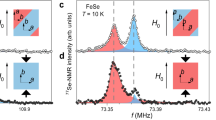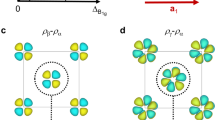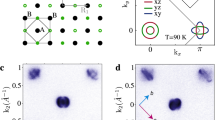Abstract
Over the past few years iron chalcogenides have been intensively studied as part of the wider family of iron-based superconductors, with many intriguing results reported so far on intercalated and monolayer FeSe. Nevertheless, bulk FeSe itself remains an unusual case when compared with pnictogen-based iron superconductors, and may hold clues to understanding the more exotic derivatives of the FeSe system. The FeSe phase diagram is distinct from the pnictides: the orthorhombic distortion, which is likely to be of a ‘spin-nematic’ nature in numerous pnictides, is not accompanied by magnetic order in FeSe, and the superconducting transition temperature Tc rises significantly with pressure before decreasing. Here we show that the magnetic interactions in FeSe, as opposed to most pnictides, demonstrate an unusual and unanticipated frustration, which suppresses magnetic (but not nematic) order, triggers ferro-orbital order in the nematic phase and can naturally explain the non-monotonic pressure dependence of the superconducting critical temperature Tc(P).
This is a preview of subscription content, access via your institution
Access options
Subscribe to this journal
Receive 12 print issues and online access
$209.00 per year
only $17.42 per issue
Buy this article
- Purchase on Springer Link
- Instant access to full article PDF
Prices may be subject to local taxes which are calculated during checkout




Similar content being viewed by others
References
Chubukov, A. Pairing mechanism in Fe-based superconductors. Annu. Rev. Condens. Matter Phys. 3, 57–92 (2012).
Hirschfeld, P. J., Korshunov, M. M. & Mazin, I. I. Gap symmetry and structure of Fe-based superconductors. Rep. Prog. Phys. 74, 124508 (2011).
Wang, F., Zhai, H. & Lee, D.-H. Antiferromagnetic correlation and the pairing mechanism of the cuprates and iron pnictides: A view from the functional renormalization group studies. Europhys. Lett. 85, 37005 (2009).
Chubukov, A. V., Efremov, D. V. & Eremin, I. Magnetism, superconductivity, and pairing symmetry in iron-based superconductors. Phys. Rev. B 78, 134512 (2008).
Stanev, V., Kang, J. & Tesanovic, Z. Spin fluctuation dynamics and multiband superconductivity in iron pnictides. Phys. Rev. B 78, 184509 (2008).
Kuroki, K. et al. Unconventional pairing originating from the disconnected Fermi surfaces of superconducting LaFeAsO1−xFx . Phys. Rev. Lett. 101, 087004 (2008).
Graser, S., Maier, T. A., Hirschfeld, P. J. & Scalapino, D. J. Near-degeneracy of several pairing channels in multiorbital models for the Fe pnictides. New J. Phys. 11, 025016 (2009).
Sknepnek, R., Samolyuk, G., Lee, Y.-B. & Schmalian, J. Anisotropy of the pairing gap of FeAs-based superconductors induced by spin fluctuations. Phys. Rev. B 79, 054511 (2009).
Guterding, D., Jeschke, H. O., Hirschfeld, P. J. & Valentí, R. Unified picture of the doping dependence of superconducting transition temperatures in alkali metal/ammonia intercalated FeSe. Phys. Rev. B 91, 041112 (2015).
Seo, K., Bernevig, B. A. & Hu, J. Pairing symmetry in a two-orbital exchange coupling model of oxypnictides. Phys. Rev. Lett. 101, 206404 (2008).
Lv, W., Krüger, F. & Phillips, P. Orbital ordering and unfrustrated (π, 0) magnetism from degenerate double exchange in the iron pnictides. Phys. Rev. B 82, 045125 (2010).
Dai, P., Hu, J. & Dagotto, E. Magnetism and its microscopic origin in iron-based high-temperature superconductors. Nature Phys. 8, 709–718 (2012).
Moon, S. J. et al. Dual character of magnetism in EuFe2As2: Optical spectroscopic and density-functional calculation study. Phys. Rev. B 81, 205114 (2010).
Lee, H., Zhang, Y.-Z., Jeschke, H. O. & Valentí, R. Possible origin of the reduced ordered magnetic moment in iron pnictides: A dynamical mean-field theory study. Phys. Rev. B 81, 220506 (2010).
Yin, Z. P., Haule, K. & Kotliar, G. Kinetic frustration and the nature of the magnetic and paramagnetic states in iron pnictides and iron chalcogenides. Nature Mater. 10, 932–935 (2011).
Chandra, P., Coleman, P. & Larkin, A. I. Ising transition in frustrated Heisenberg models. Phys. Rev. Lett. 64, 88–91 (1990).
Zhao, J. et al. Spin waves and magnetic exchange interactions in CaFe2As2 . Nature Phys. 5, 555–560 (2009).
Diallo, S. O. et al. Itinerant magnetic excitations in antiferromagnetic CaFe2As2 . Phys. Rev. Lett. 102, 187206 (2009).
Yaresko, A. N., Liu, G.-Q., Antonov, V. N. & Andersen, O. K. Interplay between magnetic properties and Fermi surface nesting in iron pnictides. Phys. Rev. B 79, 144421 (2009).
Li, S. et al. First-order magnetic and structural phase transitions in Fe1+ySexTe1+x . Phys. Rev. B 79, 054503 (2009).
Bao, W. et al. Tunable (δπ, δπ)-type antiferromagnetic order in α-Fe(Te, Se) superconductors. Phys. Rev. Lett. 102, 247001 (2009).
Ma, F., Ji, W., Hu, J., Lu, Z.-Y. & Xiang, T. First-principles calculations of the electronic structure of tetragonal α-FeTe and α-FeSe crystals: Evidence for a bicollinear antiferromagnetic order. Phys. Rev. Lett. 102, 177003 (2009).
Ferrer, J. Spin-liquid phase for the frustrated quantum Heisenberg antiferromagnet on a square lattice. Phys. Rev. B 47, 8769–8782 (1993).
Sindzingre, P., Shannon, N. & Momoi, T. Phase diagram of the spin-1/2 J1–J2–J3 Heisenberg model on the square lattice. J. Phys. Conf. Ser. 200, 022058 (2010).
Wysocki, A. L., Belashchenko, K. D. & Antropov, V. P. Consistent model of magnetism in ferropnictides. Nature Phys. 7, 485–489 (2011).
Hu, J., Xu, B., Liu, W., Hao, N.-N. & Wang, Y. Unified minimum effective model of magnetic properties of iron-based superconductors. Phys. Rev. B 85, 144403 (2012).
Fernandes, R. M., Chubukov, A. V., Knolle, J., Eremin, I. & Schmalian, J. Preemptive nematic order, pseudogap, and orbital order in the iron pnictides. Phys. Rev. B 85, 024534 (2012).
Xu, C., Müller, M. & Sachdev, S. Ising and spin orders in the iron-based superconductors. Phys. Rev. B 78, 020501 (2008).
Baek, S.-H. et al. Orbital-driven nematicity in FeSe. Nature Mater. 14, 210–214 (2015).
Böhmer, A. E. et al. Origin of the tetragonal-to-orthorhombic phase transition in FeSe: A combined thermodynamic and NMR study of nematicity. Phys. Rev. Lett. 114, 027001 (2015).
Medvedev, S. et al. Electronic and magnetic phase diagram of β-Fe1.01Se with superconductivity at 36.7 K under pressure. Nature Mater. 8, 630–633 (2009).
Landau, D. P. & Binder, K. Phase diagrams and critical behavior of Ising square lattices with nearest-, next-nearest-, and third-nearest-neighbor couplings. Phys. Rev. B 31, 5946–5953 (1985).
Cao, H.-Y., Chen, S., Xiang, H. & Gong, X.-G. Antiferromagnetic ground state with pair-checkerboard order in FeSe. Phys. Rev. B 91, 020504 (2015).
Glasbrenner, J. K., Velev, J. P. & Mazin, I. I. First-principles study of the minimal model of magnetic interactions in Fe-based superconductors. Phys. Rev. B 89, 064509 (2014).
Luo, Q. & Dagotto, E. Magnetic phase diagram of a five-orbital Hubbard model in the real-space Hartree–Fock approximation varying the electronic density. Phys. Rev. B 89, 045115 (2014).
Parker, D. R. et al. Control of the competition between a magnetic phase and a superconducting phase in cobalt-doped and nickel-doped NaFeAs using electron count. Phys. Rev. Lett. 104, 057007 (2010).
Rosenthal, E. P. et al. Visualization of electron nematicity and unidirectional antiferroic fluctuations at high temperatures in NaFeAs. Nature Phys. 10, 225–232 (2014).
Mannella, N. The magnetic moment enigma in Fe-based high temperature superconductors. J. Phys. Condens. Matter 26, 473202 (2014).
Yin, Z. P., Haule, K. & Kotliar, G. Spin dynamics and orbital-antiphase pairing symmetry in iron-based superconductors. Nature Phys. 10, 845–850 (2014).
Chubukov, A. V., Fernandes, R. M. & Schmalian, J. Origin of nematic order in FeSe. Phys. Rev. B 91, 201105 (2015).
Wang, F., Kivelson, S. & Lee, D.-H. Is FeSe a nematic quantum paramagnet? Nature Phys. 11,http://dx.doi.org/10.1038/nphys3456 (in the press) (2015).
Rahn, M. C., Ewings, R. A., Sedlmaier, S. J., Clarke, S. J. & Boothroyd, A. T. Strong (π, 0) spin fluctuations in β-FeSe observed by neutron spectroscopy. Phys. Rev. B 91, 180501 (2015).
Tucker, G. S. et al. Magnetic excitations in underdoped Ba(Fe1−xCox)2As2 with x = 0.047. Phys. Rev. B 86, 024505 (2012).
Terashima, T. et al. Anomalous Fermi surface in FeSe seen by Shubnikov–de Haas oscillation measurements. Phys. Rev. B 90, 144517 (2014).
Watson, M. D. et al. Dichotomy between the hole and electrons behavior in multiband FeSe probed by ultrahigh magnetic fields. Phys. Rev. Lett. 115, 027006 (2015).
Terashima, T. et al. Pressure-induced antiferromagnetic transition and phase diagram in FeSe. J. Phys. Soc. Jpn 84, 063701 (2015).
Bendele, M. et al. Pressure induced static magnetic order in superconducting FeSe1−x . Phys. Rev. Lett. 104, 087003 (2010).
Millis, A. J., Sachdev, S. & Varma, C. M. Inelastic scattering and pair breaking in anisotropic and isotropic superconductors. Phys. Rev. B 37, 4975–4986 (1988).
Nandi, S. et al. Anomalous suppression of the orthorhombic lattice distortion in superconducting Ba(Fe1−xCox)2As2 single crystals. Phys. Rev. Lett. 104, 057006 (2010).
Dewhurst, K. et al. ELK FP-LAPW Code http://elk.sourceforge.net (Halle and Uppsala, 2009).
Blaha, P., Schwarz, K., Madsen, G. K. H., Kvasnicka, D. & Luitz, J. WIEN2k, an Augmented Plane Wave + Local Orbitals Program for Calculating Crystal Properties (Techn. Univ. Wien, 2001).
Koepernik, K. & Eschrig, H. Full-potential nonorthogonal local-orbital minimum-basis band-structure scheme. Phys. Rev. B 59, 1743–1757 (1999).
Perdew, J. P., Burke, K. & Ernzerhof, M. Generalized gradient approximation made simple. Phys. Rev. Lett. 77, 3865–3868 (1996).
Margadonna, S. et al. Pressure evolution of the low-temperature crystal structure and bonding of the superconductor FeSe (Tc = 37 K). Phys. Rev. B 80, 064506 (2009).
Moriya, T. Spin Fluctuations in Itinerant Electron Magnetism (Springer, 1985).
Acknowledgements
We thank M. Tomić for running some test calculations at the initial stages of this work and D. Guterding, S. Backes, A. Coldea, A. Chubukov, N. Perkins, S. Kivelson and W. Ku for valuable discussions. I.I.M. is supported by ONR through the NRL Basic Research Program. J.K.G. acknowledges the support of the NRC Program at NRL. H.O.J. and R.V. are supported by DFG-SPP1458. P.J.H. was partially supported by US DOE DE-FG02-05ER46236. R.M.F. is supported by the US Department of Energy, Office of Science, Basic Energy Sciences, under award number DE-SC0012336. I.I.M., R.V. and P.J.H. were supported in part by KITP under NSF grant PHY11-25915.
Author information
Authors and Affiliations
Contributions
I.I.M. and J.K.G. conceived the research; J.K.G., I.I.M. and H.O.J. carried out numerical calculations; R.M.F. carried out analytical calculations for the phenomenological model; all authors participated in the discussion and contributed to writing the paper; I.I.M. and R.V. supervised the whole project.
Corresponding author
Ethics declarations
Competing interests
The authors declare no competing financial interests.
Supplementary information
Supplementary information
Supplementary information (PDF 967 kb)
Rights and permissions
About this article
Cite this article
Glasbrenner, J., Mazin, I., Jeschke, H. et al. Effect of magnetic frustration on nematicity and superconductivity in iron chalcogenides. Nature Phys 11, 953–958 (2015). https://doi.org/10.1038/nphys3434
Received:
Accepted:
Published:
Issue Date:
DOI: https://doi.org/10.1038/nphys3434
This article is cited by
-
Unconventional superconductivity near a nematic instability in a multi-orbital system
npj Quantum Materials (2024)
-
Order from disorder phenomena in BaCoS2
Communications Physics (2024)
-
Nanoscale inhomogeneity and the evolution of correlation strength in FeSe\(_{1-x}\)S\(_x\)
Nano Convergence (2023)
-
Dirac-fermion-assisted interfacial superconductivity in epitaxial topological-insulator/iron-chalcogenide heterostructures
Nature Communications (2023)
-
Kondo interaction in FeTe and its potential role in the magnetic order
Nature Communications (2023)



